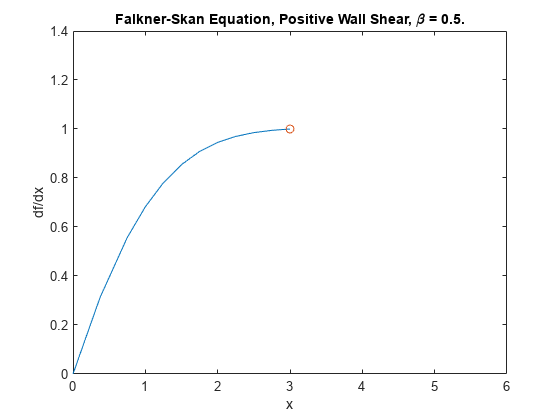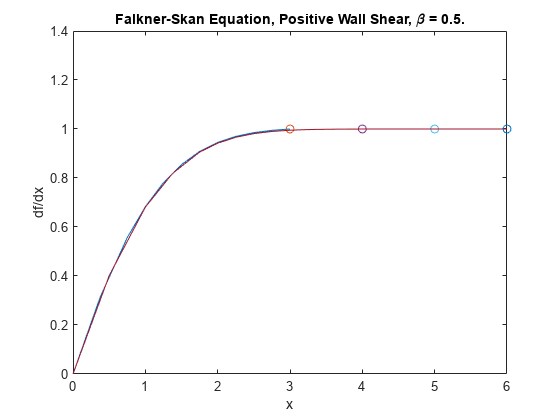연속법(Continuation)을 사용하여 BVP 일관성 확인하기
이 예제에서는 연속법(Continuation)을 사용하여 BVP 해를 더 큰 구간으로 조금씩 확장하는 방법을 보여줍니다.
포크너-스칸(Falkner-Skan) 경계값 문제 [1]은 평판 위를 흐르는 점성 있는 비압축성 층류의 상사해(Similarity Solution)를 구할 때 제기됩니다. 예제 수식은 다음과 같습니다.
.
문제는 로 무한 구간 에 있으며 다음 경계 조건이 적용됩니다.
,
,
.
무한 구간에서는 BVP를 풀 수 없으며 매우 큰 유한 구간에서 BVP를 푸는 것은 실용적이지 않습니다. 대신, 이 예제에서는 작은 구간 에 있는 일련의 여러 문제를 풀어 일 때 해가 일관된 동작을 하는지 확인합니다. 이렇게 문제를 더 간단한 문제로 나누어 각 문제의 해를 다음 문제의 초기 추측값으로 활용하는 방법을 연속법(Continuation)이라고 합니다.
MATLAB®에서 이 연립방정식을 풀려면 경계값 문제 솔버 bvp4c를 호출하기 전에 방정식, 경계 조건 및 옵션을 코딩해야 합니다. 필요한 함수를 이 예제와 같이 파일 끝에 로컬 함수로 포함시킬 수도 있고, MATLAB 경로에 있는 디렉터리에 이름이 지정된 별도의 파일로 저장할 수도 있습니다.
방정식 코딩하기
방정식을 코딩하는 함수를 만듭니다. 이 함수는 시그니처 dfdx = fsode(x,f)를 사용해야 합니다. 여기서,
x는 독립 변수입니다.
f는 종속 변수입니다.
대입 , 및 를 사용하여 3계 방정식을 1계 연립방정식으로 다시 작성할 수 있습니다. 다음과 같은 방정식이 됩니다.
,
,
.
대응하는 함수는 다음과 같습니다.
function dfdeta = fsode(x,f) b = 0.5; dfdeta = [ f(2) f(3) -f(1)*f(3) - b*(1 - f(2)^2) ]; end
참고: 모든 함수는 예제 끝에 로컬 함수로 포함되어 있습니다.
경계 조건 코딩하기
이제 경계점에서 경계 조건의 잔차 값을 반환하는 함수를 작성합니다. 이 함수는 시그니처 res = fsbc(f0,finf)를 사용해야 합니다. 여기서,
f0은 구간의 시작 부분에서의 경계 조건 값입니다.finf는 구간의 끝부분에서의 경계 조건 값입니다.
잔차 값을 계산하려면 형식의 경계 조건을 넣어야 합니다. 이 형식에서 경계 조건은 다음과 같습니다.
,
,
.
대응하는 함수는 다음과 같습니다.
function res = fsbc(f0,finf) res = [f0(1) f0(2) finf(2) - 1]; end
초기 추측값 만들기
마지막으로 해에 대한 초기 추측값을 제공해야 합니다. 구간 에 대한 수렴을 구하기 위해서는 경계 조건을 충족하는 상수 추측값 하나와 5개 점으로 구성된 엉성한 메시면 충분합니다. 변수 infinity는 적분 구간의 오른쪽 한계를 나타냅니다. 후속 반복에서 infinity 값이 3에서 최댓값 6으로 증가함에 따라 각각의 이전 반복의 해가 다음 반복에 대한 초기 추측값으로 적용됩니다.
infinity = 3; maxinfinity = 6; solinit = bvpinit(linspace(0,infinity,5),[0 0 1]);
방정식 풀기 및 해 플로팅하기
초기 구간 에서 문제를 풉니다. 해를 플로팅하고 의 값을 해석적 값 [1]과 비교합니다.
sol = bvp4c(@fsode,@fsbc,solinit); x = sol.x; f = sol.y; plot(x,f(2,:),x(end),f(2,end),'o'); axis([0 maxinfinity 0 1.4]); title('Falkner-Skan Equation, Positive Wall Shear, \beta = 0.5.') xlabel('x') ylabel('df/dx') hold on

fprintf('Cebeci & Keller report that f''''(0) = 0.92768.\n')Cebeci & Keller report that f''(0) = 0.92768.
fprintf('Value computed using infinity = %g is %7.5f.\n', ... infinity,f(3,1))
Value computed using infinity = 3 is 0.92915.
이제 각 반복에 대한 infinity의 값을 증가시켜 점점 큰 구간에서 문제를 풉니다. bvpinit는 다음 차례 infinity 값의 초기 추측값으로 작용하도록 각 해를 새 구간에 외삽합니다. 각 반복은 계산된 값을 출력하고 이전 해 위에 해의 플롯을 겹쳐 놓습니다. infinity = 6일 때, 해의 일관된 동작이 분명하게 드러나고 의 값은 예측 값에 매우 가깝습니다.
for Bnew = infinity+1:maxinfinity solinit = bvpinit(sol,[0 Bnew]); % Extend solution to new interval sol = bvp4c(@fsode,@fsbc,solinit); x = sol.x; f = sol.y; fprintf('Value computed using infinity = %g is %7.5f.\n', ... Bnew,f(3,1)) plot(x,f(2,:),x(end),f(2,end),'o'); drawnow end
Value computed using infinity = 4 is 0.92774. Value computed using infinity = 5 is 0.92770. Value computed using infinity = 6 is 0.92770.
hold off
로컬 함수(Local Function)
BVP 솔버 bvp4c가 해를 계산하기 위해 호출하는 로컬 헬퍼 함수는 다음과 같습니다. 또는 이러한 함수를 MATLAB 경로에 있는 디렉터리에 고유의 파일로 저장할 수도 있습니다.
function dfdeta = fsode(x,f) % equation being solved dfdeta = [ f(2) f(3) -f(1)*f(3) - 0.5*(1 - f(2)^2) ]; end %------------------------------------------- function res = fsbc(f0,finf) % boundary conditions res = [f0(1) f0(2) finf(2) - 1]; end %-------------------------------------------
참고 문헌
[1] Cebeci, T. and H. B. Keller. "Shooting and Parallel Shooting Methods for Solving the Falkner-Skan Boundary-layer Equation." J. Comp. Phys., Vol. 7, 1971, pp. 289-300.